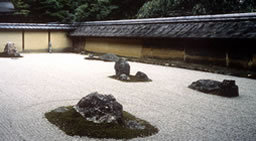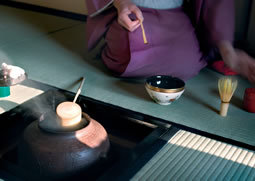
http://www.activetours.co.jp/en/
Mobile Website
Mobile Website
Active Tours
2-3-7 Yahatacho, Musashino, Tokyo 180-0011
TEL:0422-38-8026
FAX:0422-38-8036
TEL:0422-38-8026
FAX:0422-38-8036
005719
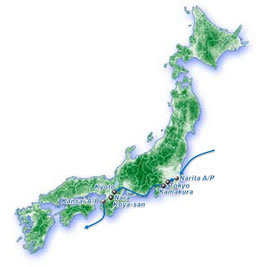
ZEN was first introduced into Japan from China in the 7th century. However, the formation of an independent sect was first created by the Rinzai Monk “Ei-sai” in the12th century. Ei-sai is also linked to the introduction of tea-drinking in Japan and even the non-religious were strongly influenced by the spirit of Zen and the Tea Ceremony.
ZEN is not an intellectual philosophy or pursuit. ZEN training emphasizes the practice of daily life, along with intensive periods of meditation. In explaining Zen Buddhism, Japanese Zen teachers have made the point that Zen is a “way of life”. With this open attitude, many non-Buddhist people in Japan and also from overseas countries practice Za-Zen.
“Zen” is not to be understood, “Zen” is to be lived. Through the spirit of Zen & Buddhist Culture , the image of Japanese culture to be caught.
10-day Tour; with a full touring programme will satisfy not only those interested in religion but also those interested in Japanese Culture.
Practice of Za-Zen, Zen cuisine, Tea Ceremony, Beautiful Buddhism statue and Zen gardens will inspire you beyond religion.
ZEN is not an intellectual philosophy or pursuit. ZEN training emphasizes the practice of daily life, along with intensive periods of meditation. In explaining Zen Buddhism, Japanese Zen teachers have made the point that Zen is a “way of life”. With this open attitude, many non-Buddhist people in Japan and also from overseas countries practice Za-Zen.
“Zen” is not to be understood, “Zen” is to be lived. Through the spirit of Zen & Buddhist Culture , the image of Japanese culture to be caught.
10-day Tour; with a full touring programme will satisfy not only those interested in religion but also those interested in Japanese Culture.
Practice of Za-Zen, Zen cuisine, Tea Ceremony, Beautiful Buddhism statue and Zen gardens will inspire you beyond religion.
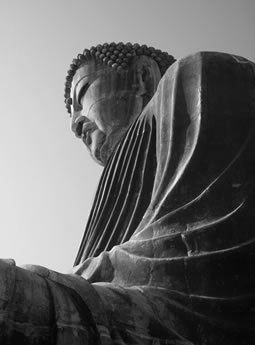
|
Kamakura became the political center of Japan, when Minamoto Yoritomo chose the city as the seat for his new military government in 1192. Hojo Tokiyori, ruled Japan after Minamoto, was a strong supporter of Zen and built Kencho-ji temple. His son built Engaku-ji, and thus Kamakura became famous for Zen Temples.
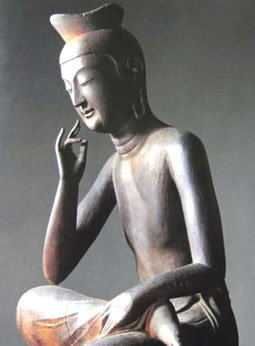
|
Miroku Bosatsu at Koryu-ji.
Koryu-ji, the oldest temple in Kyoto, was established to honour Prince Shotoku who was an ardent advocator of Buddhism, in 622. Koryu-ji was reconstructed in 1165. Miroku Bosatsu (Buddha of the future) from the 7th century is said to be the oldest and the most beautiful image in Japan.
Koryu-ji, the oldest temple in Kyoto, was established to honour Prince Shotoku who was an ardent advocator of Buddhism, in 622. Koryu-ji was reconstructed in 1165. Miroku Bosatsu (Buddha of the future) from the 7th century is said to be the oldest and the most beautiful image in Japan.
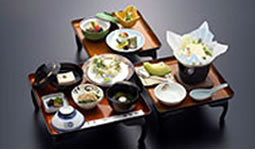
|
“Shuku-bo” in Koya-san accommodates the visitors with the traditional customs and manners typical in the mountainous areas. At many shukubo, guests have also the opportunity to participate in the morning prayers, starts at 06:00 am. The meals served at temple lodgings are shojin ryori (literally means meals to help people in devotion) the vegetarian cuisine of monks.
|
Day 1
Narita Int’l Airport arrival | Tokyo |
Meet and greet by a guide and proceed to Tokyo. City tour, if time permits. (Tokyo)
|
|
Day 2
Tokyo |
Full-day tour of Tokyo, visiting Meiji Shrine for private purification and enjoy “Kagura” dance & music, Asakusa (Senso-ji & Nakamise) and Tokyo National Museum (collection of National Treasury of Buddhism including Zen-schools). (Tokyo)
|
|
Day 3
Tokyo (Kamakura Excursion) |
Full-day excursion trip to Kamakura, once was Japan’s capital from 1185 -1333. Visit Kencho-ji and Engaku-ji, both are Zen temples built in the 13th Century. Then Visit Tsuruga- oka Hachiman-gu Shrine, built in the 11th Century, and the Great Buddha statue at Kotoku-in temple. The Great Buddha is built in 13th century, but it is unknown exactly who built it. (Tokyo) |
|
Day 4
Tokyo | Kyoto |
Board on JR Tokaido-Shinkansen (bullet train) for Kyoto. Upon arrival, city tour of Kyoto, visiting Koryu-ji to admire the statue of Miroku Bosatsu, one of the best beloved images in Japan, and is considered the top National Treasure. Then visit Ryoan-ji famous for its rock garden designed in the 15th Century. (Kyoto) |
|
Day 5
Kyoto |
Visit Koun-ji, one of the sub-temples of Nanzen-ji to practice Za-Zen, with a lecture, transcribing a sutra and tea service. Then, visit Zen Garden in Nanzen-ji (Kochi-in), designed in the early 17th Century by Enshu Kobori, master of Tea Ceremony and Architecture. Visit also included Kinkaku-ji (golden pavilion). (Kyoto)
|
|
Day 6
Kyoto |
TrExcursion tour to Uji and visit Byodo-in temple, which is the most splendid survivor from the halcyon Fujiwara era, 11century.The Phoenix Hall, elegantly built in 1053, is all that remains of the villa-temple of the Heian nobleman. One of the earliest places where tea was grown was Uji, with its mild climate and gentle hills. Uji tea was reserved for the most exalted persons and is still ranked the nation’s best. (Kyoto) |
|
Day 7
Kyoto | Nara |
Tour of Nara by coach, the Imperial Capital 710-784, visiting the National Museum which has a fine and instructive exhibit of Buddhist Art. Then to Todai-ji (the temple of the Great Buddha) and Horyu-ji, the most precious of Japan’s temples and which contains the oldest wooden structures in the world. (Nara) |
|
Day 8
Nara | Koya-san |
Transfer to Koya-san. Visit Okuno-in, the mausoleum of Kukai (Kobodaishi). On the both sides of cemetery path a half million tombs develop impressive aspect. Then visit Kongo-bu-ji complex, head- quarter of the Shingon-shu (sect), and Konpondaito Pagoda. Overnight at “Shukubo(Sub-temple)” in Koya-san (Mt. Koya), with “Shojin-Ryori” Dinner |
|
Day 9
Koya-san | Osaka |
Descend the Mountain by cable-car and take a train for Osaka.
Overnight in Osaka.? (Osaka) |
|
Day 10
Osaka | Kansai Int’l Airport (KIX) |
Transfer to Kansai International Airport by coach.
Tour ends at airport. |





